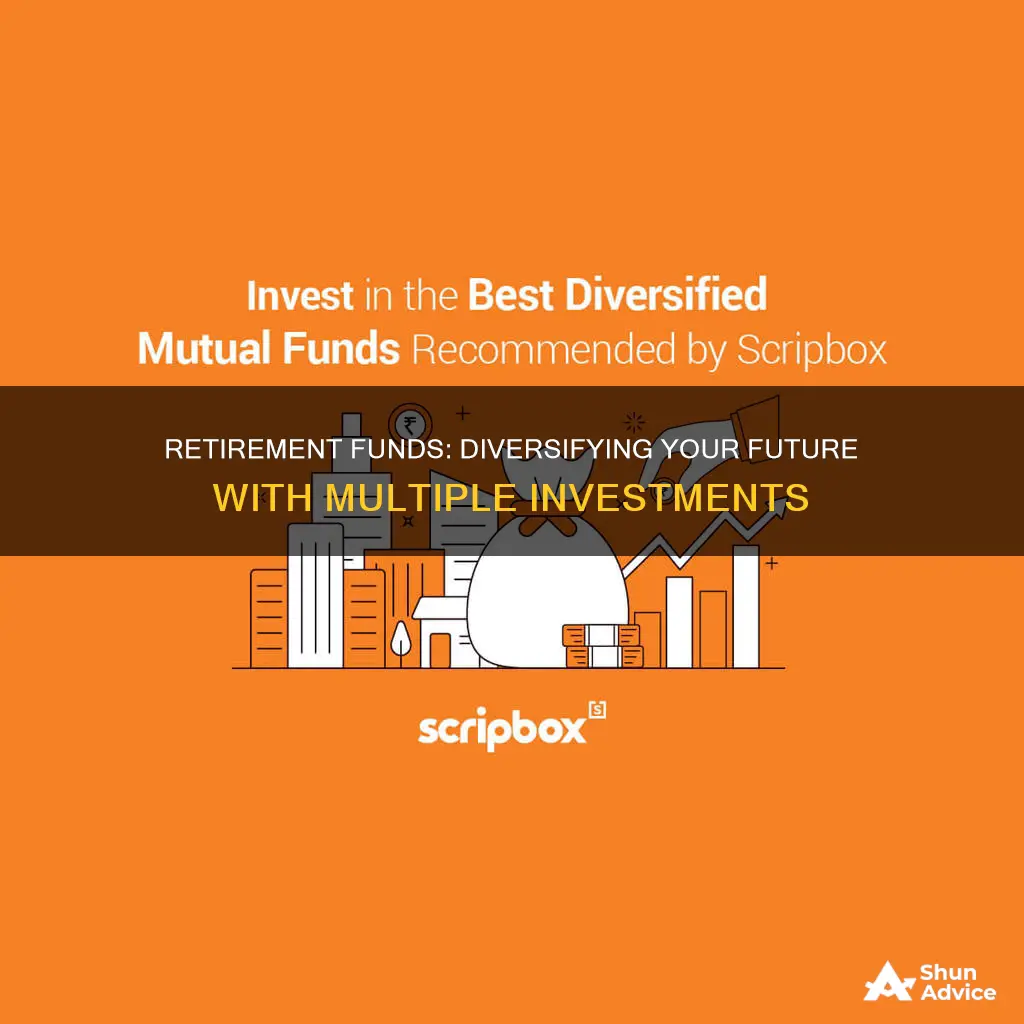
Retirement is a long-term goal, and it's reasonable to plan for one that lasts 30 years or more. Creating a savings plan is the first step, followed by choosing the right mix of investments, and finally, creating a plan for withdrawing your money. While there is no one-size-fits-all solution, there are a few things to consider when deciding whether to invest in multiple retirement funds. Firstly, having multiple accounts from different employers can cost you time and money in the long run due to management fees and administrative burdens. Consolidating accounts can lower fees, reduce legwork, and make it easier for your beneficiaries to manage your estate. However, if you are satisfied with a former employer's plan and the account balance is above a certain threshold, you may choose to keep your funds there. Secondly, the number of funds you need depends on your risk tolerance, goals, and investment strategy. While a single fund may be sufficient for some, others may prefer the diversification and ultra-low costs offered by a combination of two or three funds. Ultimately, the right approach depends on your individual circumstances, and it's essential to carefully consider your options before making any decisions.
| Characteristics | Values |
|---|---|
| Number of retirement funds | 3 funds are sufficient for most people, but 2 or even 1 fund can be enough |
| Type of funds | Index funds or exchange-traded funds (ETFs) |
| Diversification | Important to diversify your investments to avoid overlapping holdings |
| Tax efficiency | Consider tax-free accounts like a Roth IRA or HSA |
| Risk tolerance | Consider your age, goals, and risk tolerance when deciding on an allocation |
| Asset allocation | Divide your money among stocks, bonds, and cash according to your risk tolerance |
| Management | You can manage your retirement funds yourself or use a robo-advisor |
| Fees | Consider fees when choosing a fund, as they can eat into your balances |
| Consolidation | Consolidating multiple accounts can save time and money |
What You'll Learn

The benefits of consolidating multiple retirement accounts
Consolidating multiple retirement accounts can be beneficial for a few reasons. Firstly, it can save you time and money by reducing the number of accounts you need to manage and the associated administration fees. If you have multiple accounts from different employers, consolidating them can make it easier for you to monitor your investments and keep track of your investment dollars.
Another advantage of consolidating accounts is that it simplifies the process of estate management for your beneficiaries in the event of your passing. They will only have to deal with a single account, which makes it easier to locate, manage, and distribute the assets.
Consolidating retirement accounts can also lower your fees. Retirement accounts often charge management fees, such as annual fees or fees for paper statements. By consolidating your smaller balances into one individual retirement account (IRA) or rolling past accounts into your current 401(k), you will only be subject to a single set of fees, reducing the impact on your balances.
Additionally, consolidating accounts can reduce the amount of legwork and maintenance required. With multiple accounts, you would need to keep track of each one and take required minimum distributions (RMDs) from traditional IRAs and 401(k)s separately. Consolidating your accounts keeps all your money together, allowing you to take a single RMD and giving you more flexibility in managing your investments.
Lastly, consolidating accounts can provide peace of mind. Having multiple accounts from different employers can be overwhelming, and consolidating them can make it easier for you to make informed decisions about your retirement savings.
Janus Funds: A Smart Investment Strategy?
You may want to see also

The pros and cons of different types of retirement funds
Retirement funds are an important part of financial planning, and there are a few options to consider when it comes to choosing the right type of account. Here are the pros and cons of different types of retirement funds:
Multiple Retirement Funds
Having multiple retirement accounts can provide the benefit of diversification and ensure your assets are not all in one place. This strategy can be especially appealing if you've changed jobs multiple times and have different 401(k) plans or IRAs. However, there are several drawbacks to this approach:
- Costs and Fees: Multiple accounts can lead to higher costs and fees, including management fees, maintenance fees, and administrative fees. Consolidating accounts can help reduce these fees.
- Time and Effort: Managing multiple accounts can be confusing, time-consuming, and frustrating due to the need to track multiple statements, forms, passwords, and more.
- Redundancies and Overlap: Different accounts may have similar holdings, leading to redundancies and overlap in your investments. This can impact the overall diversification of your portfolio.
- Complexity and Decision-Making: With multiple accounts, it can be challenging to get a holistic view of your investments and make informed decisions about your risk tolerance, goals, and investment strategy.
- Paperwork and Compliance: Multiple accounts mean more paperwork and the need to regularly update beneficiaries and other information.
Single Retirement Fund
A single retirement fund, or consolidating multiple accounts into one, can offer the following benefits:
- Simplicity and Ease of Management: Having a single account makes it easier to manage your investments, monitor performance, and make adjustments as needed.
- Lower Costs: Consolidating accounts can lead to lower costs and fees, as you may be able to access lower-cost investment options or qualify for waived fees with a larger balance.
- Better Diversification: By having a holistic view of your investments in one account, you can ensure your portfolio is properly diversified and aligned with your risk tolerance and financial goals.
- Reduced Paperwork and Compliance: With a single account, you only need to deal with one set of statements, updates, and compliance requirements.
Types of Retirement Accounts
When considering different types of retirement accounts, there are a few common options:
- Traditional 401(k) or IRA: These are traditional pre-tax retirement accounts where contributions are made before taxes, and withdrawals in retirement are taxed as income.
- Roth 401(k) or Roth IRA: These accounts offer tax-free growth, meaning you pay taxes on contributions but not on withdrawals in retirement.
- Taxable Brokerage Account: This is a regular investment account that doesn't offer tax advantages but provides flexibility in the types of investments you can hold.
- Health Savings Account (HSA): An HSA is a tax-free account specifically for qualified medical expenses. Withdrawals for non-medical expenses may be subject to taxes and penalties.
Each type of account has its own pros and cons, and the right choice depends on your individual circumstances, tax situation, and financial goals. It's important to carefully consider the benefits and features of each option before deciding.
Bond Index Funds: A Smart, Diversified Investment Strategy
You may want to see also

How to choose the right funds for your retirement portfolio
When it comes to retirement planning, there are several options to consider for your investment portfolio. Here are some guidelines on how to choose the right funds to achieve your retirement goals:
Understand Asset Allocation
Firstly, understand what asset allocation means. This simply refers to how your money is divided among different types of investments, such as stocks, bonds, and cash. For example, if you invest $10,000 in an IRA account and $6,000 of it is in stock funds and $4,000 in bond funds, your asset allocation is 60/40.
Evaluate Your Risk Tolerance
Consider your risk tolerance, which involves assessing your time horizon (how long the money will be invested) and your ability to tolerate risk. You want to take enough risk to grow your money, but not so much that you'll panic when the market becomes volatile. A common rule of thumb is to subtract your age from 100 (or 110 if you're feeling risky). The resulting number suggests the percentage of your portfolio that should be allocated to stocks. For example, if you're 30 years old, you'd allocate 70% to 80% of your portfolio to stocks.
Choose Your Investment Vehicle
You can choose to invest in individual stocks and bonds, or you can opt for mutual funds or exchange-traded funds (ETFs) for better diversification and potentially better long-term results. Mutual funds and ETFs provide a basket of investments rather than the stock of just one company, reducing individual stock risk.
Diversify Your Portfolio
When selecting funds, ensure you are diversifying across different asset classes. This could include a diversified stock fund, a total market bond fund, and an income investing option. You can also diversify within asset classes, such as investing in large-cap, small-cap, and mid-cap funds, as well as international funds.
Keep Costs Low
Passively managed index funds are a good option as they offer the lowest costs, or expense ratios, in the market. Additionally, consider the fees associated with your investments, as these can eat into your returns over time.
Rebalance Your Portfolio
Periodically check your portfolio to ensure it aligns with your desired asset allocation. Market performance may cause your portfolio to deviate from your target allocation. For example, after a strong stock market performance, you may need to sell some stocks and buy bonds to get back to your desired ratio.
Consider a Robo-Advisor or Target-Date Fund
If you don't want to actively manage your portfolio, consider using a robo-advisor or investing in a target-date fund. Robo-advisors use algorithms to manage your investments based on your age, risk tolerance, and other factors. Target-date funds are mutual funds designed for retirement around a specific year, automatically adjusting their holdings from higher-risk to lower-risk as that date approaches.
Consult Professional Advice
Retirement planning can be complex, and it's important to make informed decisions. Consider consulting a financial advisor or using online tools provided by your workplace plan or brokerage firm to help determine the right asset allocation and fund choices for your retirement goals and risk tolerance.
Maximizing Your Emergency Fund: Smart Investment Strategies
You may want to see also

The importance of asset allocation and diversification
Asset allocation and diversification are key to building a robust retirement portfolio. Here's why:
Risk Management:
Diversification helps to reduce risk by spreading your investments across various asset classes, sectors, and markets. By not putting all your eggs in one basket, you lower the chances of significant losses if a particular investment or market underperforms. For example, if you only invest in stocks and the stock market takes a dive, your portfolio will take a big hit. But if you also invest in bonds, real estate, or other assets, they can help balance out the risk and provide a cushion during stock market downturns.
Maximizing Returns:
Different asset classes perform differently over time. For example, stocks historically have provided higher returns than bonds or cash. By allocating your investments across various asset classes, you can maximize your overall returns. A well-diversified portfolio typically includes a mix of stocks, bonds, cash, and alternative investments like real estate or commodities.
Tax Efficiency:
Different types of retirement accounts, such as traditional 401(k)s, Roth IRAs, and taxable brokerage accounts, have different tax treatments. By diversifying across these accounts, you can control your taxable income in retirement and minimize your tax burden. For example, withdrawals from a Roth IRA are tax-free, while withdrawals from a traditional 401(k) are taxed as income. By strategically combining withdrawals from these accounts, you can lower your overall tax liability.
Long-Term Growth:
Asset allocation and diversification are important for long-term growth. As you approach retirement, your investment strategy may shift from aggressive to more conservative. For example, you may increase your allocation to bonds and cash to preserve capital and generate stable income. However, it's still important to maintain some exposure to stocks, as they provide growth potential to keep up with inflation and taxes.
Personalized Strategy:
Asset allocation and diversification allow you to tailor your investment strategy to your specific needs, goals, and risk tolerance. For example, if you're in your 20s or 30s, you may want to allocate more to stocks for higher potential returns. As you get older, you may shift more towards bonds and less volatile investments. Additionally, if you're comfortable with taking on more risk, you can adjust your portfolio accordingly.
In summary, asset allocation and diversification are crucial for building a robust retirement portfolio that can weather market downturns, maximize returns, minimize taxes, and provide long-term growth. By diversifying your investments and allocating them based on your goals and risk tolerance, you can feel more confident in your financial future.
Investing in Nifty Bank Index Fund: A Comprehensive Guide
You may want to see also

The role of risk tolerance in retirement investing
Risk tolerance plays a crucial role in retirement investing, and it's important to consider it when deciding whether to invest in multiple retirement funds. Here's how risk tolerance factors into retirement investing:
Understanding Risk Tolerance
Risk tolerance refers to an individual's ability and willingness to take on investment risk. It involves assessing how much risk an investor is comfortable with and their capacity to handle potential losses. Risk tolerance is influenced by various factors, including age, financial goals, income needs, time horizon, and personal comfort with volatility.
The Impact of Risk Tolerance on Retirement Investing
When it comes to retirement investing, risk tolerance helps determine the allocation of assets across different investment options. Here are some key points to consider:
- Age and Risk Tolerance: Generally, younger investors tend to have a higher risk tolerance since they have a longer time horizon until retirement. They can allocate a larger portion of their portfolio to stocks and growth-oriented investments, as they have more time to ride out market fluctuations and recover from potential losses. As investors approach retirement age, they may shift towards more conservative investments, such as bonds and fixed-income options, to preserve their capital.
- Risk and Return Trade-off: Risk and return are typically correlated. Stocks, for instance, historically offer higher returns over the long term compared to bonds or cash, but they also come with higher risk. On the other hand, bonds and fixed-income investments provide relatively lower returns but offer more stability and protection during market downturns.
- Diversification and Risk Management: Diversification is a key aspect of risk management in investing. By spreading investments across multiple asset classes, sectors, or geographic regions, investors can reduce the impact of specific risks associated with individual investments. Diversification helps smooth out the overall risk of a portfolio and can be achieved through various investment funds, including index funds, mutual funds, or exchange-traded funds (ETFs).
- Customizing Investment Strategies: Risk tolerance allows investors to customize their retirement investment strategies. For example, a three-fund portfolio, consisting of one U.S. stock fund, one international stock fund, and one bond fund, offers a balance between diversification and control over risk exposure. The allocation between these funds can be adjusted based on the investor's risk tolerance, with younger or more risk-tolerant individuals allocating more to stocks and less to bonds.
- Rebalancing and Monitoring: Risk tolerance also influences the need for active portfolio management. Investors with higher risk tolerance may be more comfortable with periodic rebalancing, ensuring their portfolio aligns with their desired asset allocation. Regular monitoring and adjustments help maintain the intended level of risk and return over time.
In summary, risk tolerance is a critical factor in retirement investing as it guides the selection and allocation of investment options. It helps individuals strike a balance between pursuing growth and managing risk, ensuring their retirement portfolios align with their financial goals, time horizons, and comfort levels.
Vanguard Index Fund: When to Invest for Maximum Returns
You may want to see also
Frequently asked questions
Diversifying your retirement savings across multiple accounts can help you control your taxable income and keep taxes low when you retire. It can also provide more flexibility for your savings and allow you to maximise the potential of different types of accounts.
While there is no one-size-fits-all answer, generally, a well-diversified retirement portfolio can be achieved with three, two, or even just one fund. The number of funds you choose depends on your personal preferences, risk tolerance, and financial goals.
Having multiple retirement accounts can cost you time and money in the long run due to higher management fees and more complex maintenance. Additionally, having too many funds may result in overlapping holdings, reducing the effectiveness of your diversification strategy.
Here are some key considerations:
- Understand asset allocation: Determine the percentage of your portfolio allocated to different types of investments, such as stocks, bonds, and cash.
- Assess your risk tolerance: Consider your time horizon and comfort with risk. Generally, younger investors can tolerate more risk, while older investors may prefer a more conservative approach.
- Consider mutual funds, index funds, or ETFs: These investment options offer better diversification and potentially lower costs compared to individual stocks and bonds.
- Know when to seek professional advice: If selecting investments feels overwhelming, consider outsourcing to a financial advisor or using a robo-advisor service.







